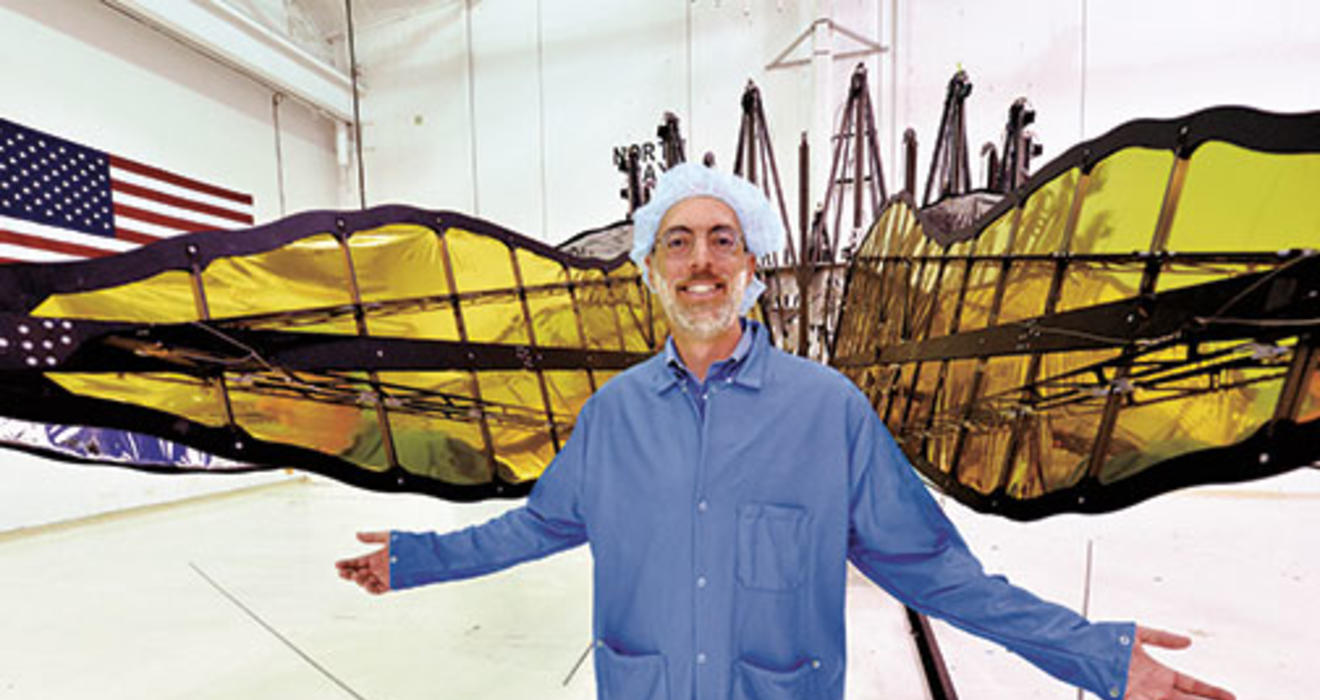
Life Among the Stars
Princeton scientists hunt for habitable planets beyond our solar system
A generation ago, the number of planets known in the universe was just nine: the nine of our solar system (then including Pluto). Scientists were almost certain there were more, but that was just a logical supposition made after they realized that stars were suns like our sun, not dots of light painted on a celestial sphere. No one could confirm they actually existed.
Technology has been solving that problem, but another big question remains: Could any of those planets sustain life? N. Jeremy Kasdin ’85, a professor of mechanical and aerospace engineering and vice dean of Princeton’s school of engineering, thinks that it could be possible to answer that question, too, within a decade or so.
“The universe is teeming with planets,” Kasdin said in Vancouver in March 2014 as he began his talk at the annual TED conference, perhaps the world’s hippest gathering on topics of technology, entertainment, and design (hence the acronym). Astronomers believe that every star in the galaxy has a planet, he explained — and up to one-fifth could have an Earth-like planet that might be able to sustain life.
Then he laid out a grandiose game plan: “to build a space telescope that will be able to image an Earth about another star and figure out whether it can harbor life.” In his six-and-a-half-minute talk, since viewed more than a million times on the Web, Kasdin described a simple idea suggested more than half a century ago by Lyman Spitzer *38, the late Princeton astrophysicist who came up with the notion of putting telescopes in space.
Just as the moon blots out the sun during a solar eclipse, Kasdin said, a large screen placed far in front of a space telescope could block the light coming from a distant star, enabling the telescope to spot much dimmer planets in orbit around that star.
“That’s not science fiction,” said Kasdin, who has been developing the technology to build just such a screen — he calls it a starshade — in collaboration with NASA’s Jet Propulsion Laboratory.
“I think this is the coolest possible science,” he concluded in his TED talk. “That’s why I got into doing this — because I think that will change the world.”
The study of planets beyond our solar system — what astronomers call extrasolar planets or exoplanets — has become one of the hottest research areas in astronomy, including at Princeton. The configuration of planets around other stars often looks very different from our solar system, which is “beginning to look odd,” says Adam Burrows, a theoretical astrophysicist at Princeton.
Some giant exoplanets, much larger than Jupiter, are broiled to thousands of degrees as they orbit their parent stars at a fraction of the distance at which Mercury circles the sun. Others are “super-Earths” — rocky planets that are several times more massive than the one we live on.
The discoveries have spurred questions, mostly unanswered. How many stars have planets? What determines whether a star has planets? What does a typical planetary system look like? How common is a place like Earth? Is there life on any of the planets, and could we tell?
Since the middle of the 19th century, astronomers have been searching for hints of unseen planets subtly changing the behavior of their parent stars. Claims of discovery came and went, discredited.
In 1992, the first two exoplanets at last were discovered and confirmed. But these orbited a pulsar — the charred remains of an exploded star. The fact that new planets could form in the aftermath of a cataclysmic explosion was a surprise, but nonetheless, the planets were largely curiosities because the chances of life arising there were considered minuscule.
At the time, Burrows was developing models to explain brown dwarfs, which are thought of as failed stars, not quite large enough to ignite. In 1995, Swiss astronomers Michel Mayor and Didier Queloz contacted him about observations they had made of a star named 51 Pegasi, 51 light-years away.
Mayor and Queloz saw clockwork fluctuations in the frequency of light from the star, which could be explained by the gravitational pull of a planet circling it. But it seemed to be an exceptionally strange planet. It was big, at least half the mass of Jupiter, yet almost hugging its parent star, orbiting at a distance that was less than one-seventh the distance at which Mercury orbits the sun. If a planet were causing the fluctuations, it was a planet that zipped around its star in just four days, versus the 365 days it takes for Earth — or the 4,332 days required for Jupiter — to complete a trip around the sun. Mayor and Queloz wanted to know if it was plausible for a planet that big to exist so close to the star.
Burrows calculated. It seemed strange, but there was no reason in physics that would make it impossible. “That emboldened the team to reveal their result,” he says. On Nov. 23, 1995, the scientific journal Nature published the discovery: the first planet found around a sunlike star outside of the solar system.
Many astronomers took a long time to believe that the weird planet really was a planet at all. Some critics suggested that perhaps 51 Pegasi was a variable star — a star whose brightness changes — and the variations in frequency arose from something going on in the star itself. “That still took a few people a few months or half a year to get their heads around it,” Burrows says. When they did, he says, “this subject started to explode.” The search for other exoplanets was on. More than 1,800 have been identified so far.
Over the first decade of the exoplanet era, the technique of radial velocity — looking for wiggles in the frequency of starlight — was the primary method of discovery. That told astronomers the distance of the planet from the star and a minimum mass, but not much else.
Others came up with different ideas. Princeton astrophysics professor Bohdan Paczynski — who initially was searching not for exoplanets but for dark matter, the unknown material that is believed to make up 85 percent of the universe — developed a technique called microlensing. When a massive object passes between Earth and a distant star, the object in the middle acts like a magnifying glass, its gravity bending and brightening the light of the distant star. It turns out that if the intervening object is a star with a planet, the planet also can be detected because its gravity bends the light but in a slightly different direction. Think of it as a small imperfection in a lens, a distortion.
The unavoidable shortcoming of this technique is that no one ever will see a microlensed planet twice, which means that follow-up observations are out of the question. Still, microlensing has revealed at least 34 exoplanets, including one of the smallest, 20,000 light-years away and about 5.5 times the mass of Earth. Researchers showed Paczynski that data before he died of cancer in April 2007.
Another, more straightforward, method is to stare at a large number of stars and look for repeated dips in brightness. The dips could be a planet passing in front, partially blocking the starlight. That is how NASA’s $600 million Kepler space telescope turned up nearly 1,000 planets after continuously observing 150,000 stars for four years. It’s also what Princeton astrophysics professor Gaspar Bakos is doing on a much smaller, cheaper scale from the ground, with a network of telescopes known as HATNet.
Bakos originally was not interested in planets, but in variable stars that pulsed in brightness or color. Sometimes the internal machinations of the star drove the changes. Sometimes a variable star turned out to be two stars orbiting each other. Such variable stars were discovered centuries ago, and thousands already had been catalogued. But Bakos figured that inexpensive telescopes could discover far more, leading to new insights.
In 1999, while still a college undergraduate in Hungary, Bakos teamed up with engineers he met through an astronomy club to build a prototype of the HAT telescope, short for Hungarian-made Automated Telescope. It consisted of a secondhand Nikon telephoto lens paired with a large image sensor. That prototype was tested at an observatory in Budapest and later at the Steward Observatory in Arizona.
The one prototype burgeoned into HATNet, six fully robotic telescopes installed at the Whipple Observatory in Arizona and Mauna Kea in Hawaii. The telescopes determine, without guidance from humans, what and when to observe, based on the weather and pre-programmed priorities.
Bakos realized that with the telescopes’ ability to spot minuscule changes in brightness, he could pivot his research to search for exoplanets. So far, HATNet has found 55 of them, including oddities like a planet that is larger than Jupiter but has just half Jupiter’s mass — a puffy planet with the unbelievably low density of cork. Another is a superheavy Jupiter — the same size yet nine times as massive.
More recently, Bakos set up HATSouth, a network of somewhat larger telescopes in the Southern Hemisphere: in South Africa, Australia, and South America. The three locations, barring clouds or malfunction, keep continuous watch on the southern night sky.
Bakos travels to repair and upgrade his telescopes. The rest of the time, he monitors events on the computer screen in his Princeton office, zipping through time-lapse movies of observations of the night before. Cameras also record the unusual, like a mule scratching its back against the dome of one of the telescopes.
“It’s a highly productive network, and it was done on a shoestring budget,” he says.
The technology of exoplanet discovery has progressed so far so quickly that it soon could be readily within the reach of amateurs and digital cameras. It would require a fancy single-lens reflex camera with a powerful telephoto lens, but still equipment anyone could buy — not just a big observatory or a multi-million-dollar NASA mission. Within a few years, Bakos says, the sensors in such cameras will be sensitive enough to discern the dimming of passing planets.
The next goal, as Kasdin explains, is to move beyond the indirect detection of planets to photographing the exoplanets themselves. Astronomers want a picture of Earth 2.0.
Once they have a picture, new avenues of research become possible. Scientists could start identifying molecules floating in the atmospheres of these Earth twins, maybe even finding the chemical fingerprints of faraway life.
Already, ground-based telescopes have taken some snapshots of exoplanets, but only big ones at a considerable distance from their stars. Kasdin’s group is constructing an instrument to be installed on the Suburu telescope in Hawaii that will study the chemical makeup of large exoplanets.
For years, NASA’s astrophysics roadmap included an ambitious, pricey mission called Terrestrial Planet Finder — an immense space telescope that could photograph smaller Earth-like planets. NASA considered two potential designs, but the idea was postponed repeatedly and scrapped in 2011.
The challenges are immense. A small planet light-years away is extremely dim. More challenging, the dim dot of light from that planet is washed out in the glare of a blindingly bright star right next to it.
Enter Kasdin’s starshade.
Because light acts like waves, the optimal shape for blocking out the light is not a circle. Some of the light bends, like water flowing around a rock. That’s part of the reason it does not become dark as night during a solar eclipse — about a thousandth of the sun’s light still makes it to the ground. To spot Earth-size planets, Kasdin says, the starshade would have to block all but one 10-billionth of the star’s light.
Kasdin and his collaborators have demonstrated that a shade shaped like the petals of a sunflower can work. The light bends less as it passes the petal shapes, and the light that does pass around the shade in effect cancels itself out, producing a darker shadow.
A prototype of a single full-size petal — 6 meters (19.7 feet) tall — was built at NASA’s Jet Propulsion Laboratory in California; a complete model with a full complement of 30 petals would be the size of half a football field. To fit inside a rocket, the starshade would have to be folded up like an umbrella, another technological challenge.
Two summers ago, four undergraduate interns from Princeton and MIT, working at the Jet Propulsion Laboratory, built four smaller petals that verified that the petals repeatedly and precisely, within a fraction of a millimeter, could unfurl to the desired shape. Kasdin says he has obtained space in the basement of Frick Chemistry Lab to build an even smaller prototype of a starshade with all its petals. Scaled down to account for the 31,000 miles of space between the telescope and the starshade, the prototype will be only 2 inches wide — allowing Kasdin to determine how dark the shadow will be.
The next likely opportunity for a space-based mission to photograph exoplanets is a Hubble-class telescope that originally was built to be a spy satellite but then was donated by the National Reconnaissance Office to NASA to be used for science. The telescope has the unwieldy name of Wide-Field Infrared Survey Telescope-Astrophysics Focused Telescope Assets and a long acronym: WFIRST-AFTA. “I think WFIRST will be the next big step on this,” says Princeton’s astrophysics department chair, Professor David Spergel ’82, who also is the co-chairman of WFIRST’s science-definition team. He hopes that NASA will give the green light to launch the mission sometime in the first half of the next decade.
The primary mission of the telescope would be to study the mysterious dark energy that appears to be accelerating the expansion of the universe. But a second objective would be to find planets through microlensing events, and a third would be to photograph planets around nearby stars — not with a starshade (though Kasdin hopes a starshade still could be incorporated), but with a technique known as a coronagraph.
Kasdin is involved with that effort, too. Unlike a starshade that would fly thousands of miles away, a coronagraph is part of the telescope’s optics, somewhat like a black spot drawn on your glasses to block out some of the light. Kasdin heads one of two teams coming up with proposals for the coronagraph design. Like a starshade, the optimal shape is not a circle, but a more intricate design. It is not quite as effective as a starshade, Kasdin says. Still, the coronagraph should allow WFIRST to get photographs of planets similar to Saturn and Uranus. WFIRST also should be able to study small gas planets known as mini-Neptunes.
Then, with photographs, astronomers can start looking at specific colors of light that are absorbed by the planets’ atmospheres, which might explain what is in the planets’ air. Even observing an Earth-size planet is possible, though Kasdin is not optimistic about that. “If you got really lucky, and everything performed right and there happened to be an Earth around a nearby star that’s bright, it could see it,” he says. “More likely not.”
Meanwhile, NASA has financed the drawing up of preliminary plans for two missions devoted to the search for exoplanets — one of them, using a starshade. But scientists think that the project — or any starshade-equipped telescope capable of photographing Earth twins — is likely to wait for the round of grand projects expected to be deployed in the late 2020s or early 2030s.
Even with the hundreds of exoplanets already discovered, astronomers have only a partial picture. They know there are many planets they cannot yet see, and understand that they sometimes draw unwarranted conclusions from sparse and noisy data. “Planets are more complicated than stars,” Burrows says.
For example, if aliens a few tens of light-years away were looking at our solar system with our technology, they would not detect eight planets but probably just two — Jupiter and Saturn. The inner rocky planets likely would be too small; Uranus and Neptune would be too far out and moving too slowly to show up in the data.
But eventually, better tools will be developed, and scientists will collect enough data for stronger conclusions. “In the next decade or two,” Burrows says, “we’re going to start making it a real science.”
Kenneth Chang ’87 is a science reporter for The New York Times.


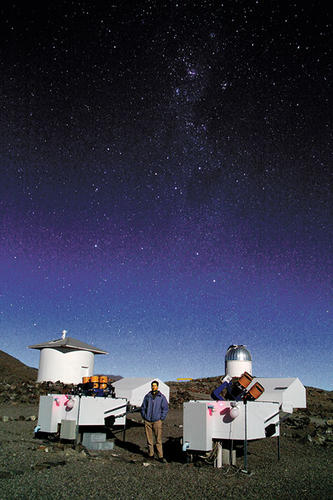
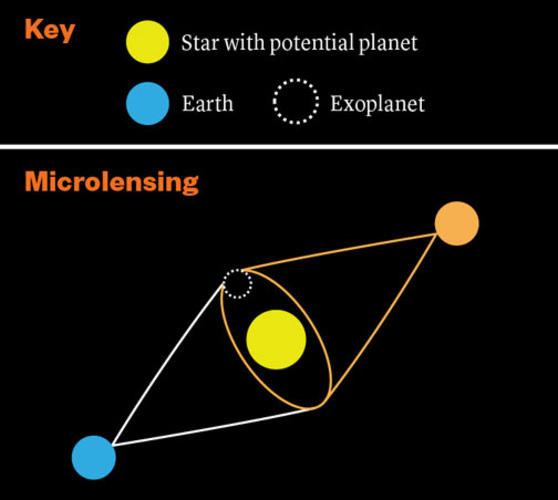
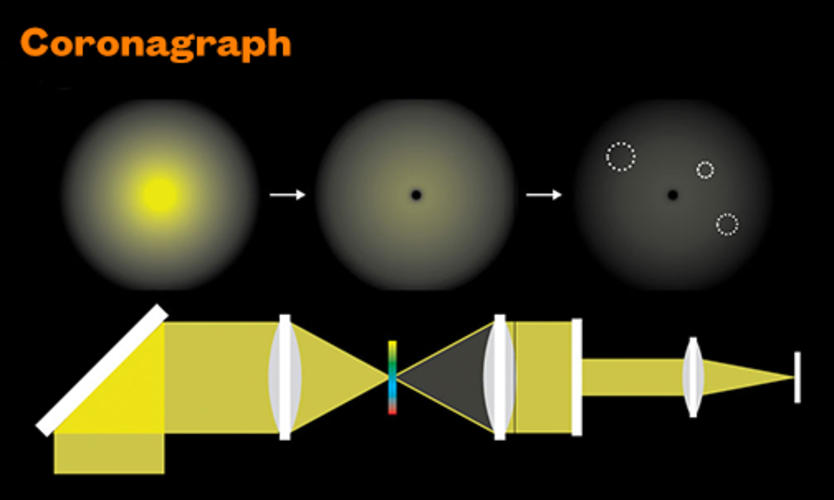
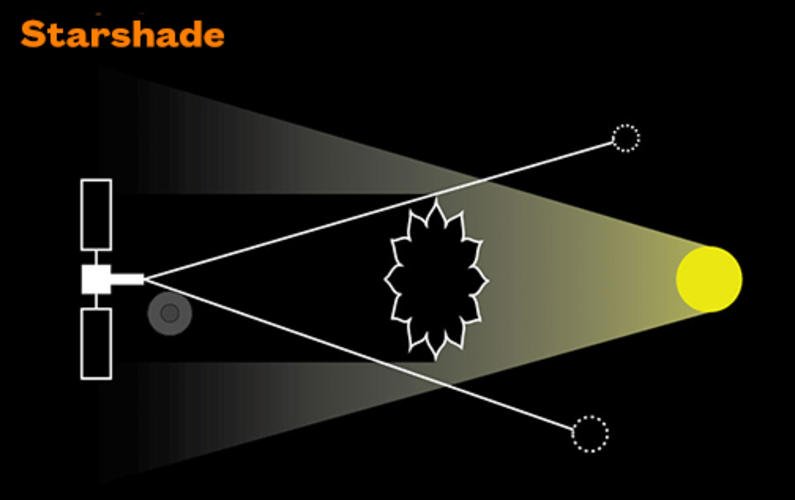




2 Responses
Francis Jacobs *66
9 Years AgoSearching for Exoplanets
Excellent presentation. Two questions: Evidently the geometry of the starshade’s “petals” is critical to minimizing diffraction. What happens if one of the petals is hit by a micrometeorite, creating a tiny pinhole? Also, how is the orientation/rotation of the “occulter” (viz. the second spacecraft that blocks the starlight) maintained with respect to the telescope?
Editor’s note: Professor N. Jeremy Kasdin ’85 offers this response: Multiple layers of insulation should prevent a light path for a typical micrometeorite strike, and the effect of a small number of chips along the edge is within our error budget. The occulter will spin about its axis. By spinning, certain localized errors are averaged and thus easily differentiated from planets. Attitude control is similar to any conventional satellite; performance is very insensitive to errors in the angle of the starshade relative to the line of sight to the star.
Kenell J. Touryan *62
9 Years AgoSearching for Exoplanets
Re “Life Among the Stars” (cover story, March 18): There may be trillions of planets in the universe. The important question to consider is what conditions should exist to make a planet habitable for animal life. Peter Ward and Donald Brownlee in their book Rare Earth: Why Complex Life Is Uncommon in the Universe show that more than 100 narrowly tuned constraints have to be satisfied for an Earth-like planet to exist. If so, this could bring the probability to one, i.e., us! Astrophysicist Frank Drake arrived at the same conclusion 40 years ago.